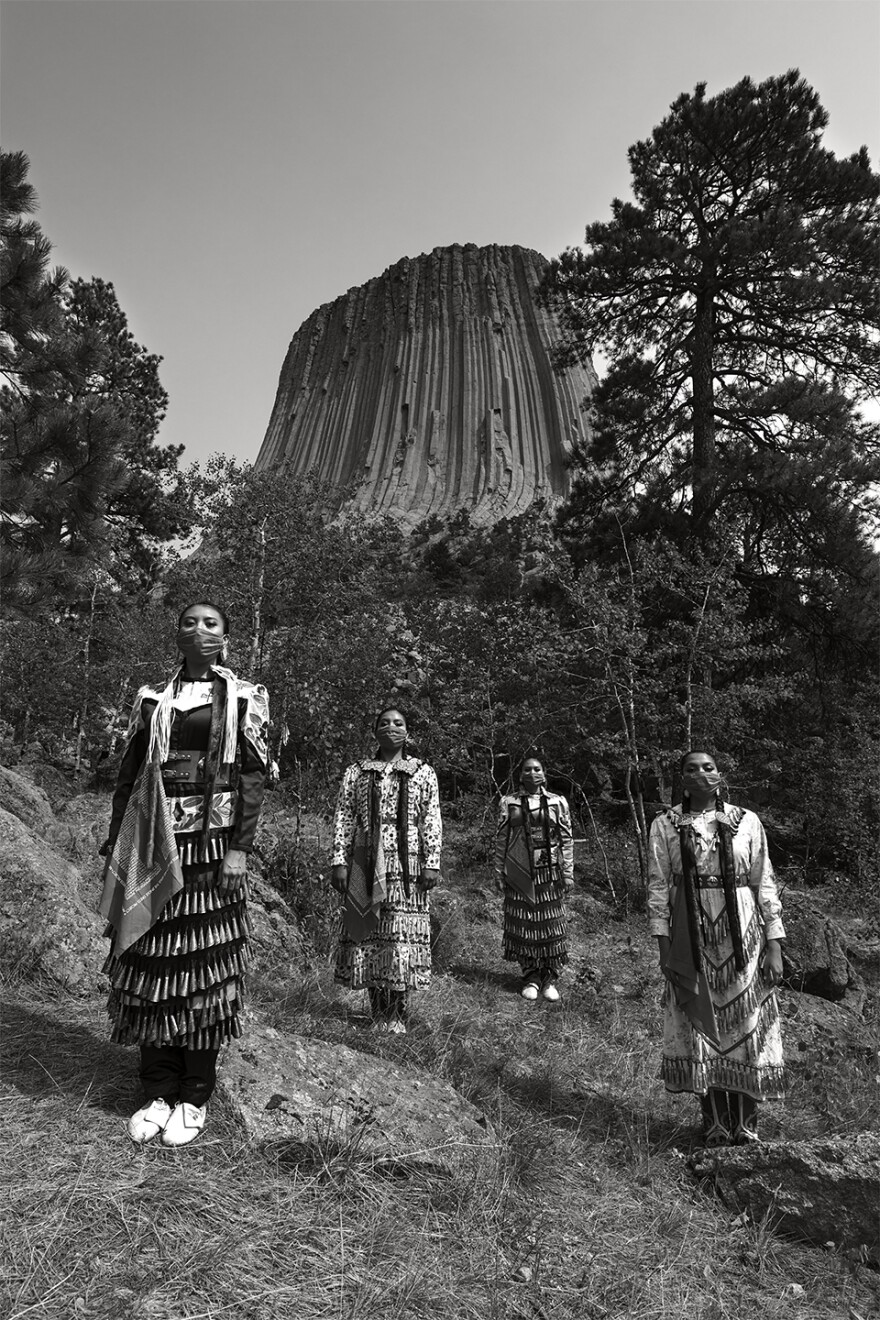A group of Native American women from Utah have spent the past year promoting healing across the U.S. by dancing in what’s called a jingle dress. The garment – with makes a distinctive rustling cascade when in motion - hearkens back to another crisis, the Spanish Influenza pandemic of 1918. KLCC recently caught up with the performers of the Jingle Dress Project, as they toured the Pacific Northwest.
In a parking lot teeming with tourists in Cannon Beach, Oregon, sisters Erin and Dion Tapahe and their friend, Sunni Begay, helped each other put on long dresses adorned with beadwork, fur, and hundreds of metal cones called “jingles”.
The process didn’t always go smoothly.
“Hahahah!” cried Begay, as Tapahe adjusted the sleeves to her dress, poking her under the arms, “Oh, you’re tickling me!”
It was a lighthearted moment for an event with somber beginnings. Erin Tapahe explained to KLCC that the jingle dress originated in Minnesota over a century ago.
“An Ojibwe father, his daughter was sick with the Spanish flu,” she said. “And he had a dream of a way to heal her. And he dreamt of the jingle dress. And when he woke up, he told his wife.
“And his wife made four jingle dresses, and four of the women in the community were dancing, and they were dancing throughout the night. And by morning, his daughter who was sick was healed.”
The Jingle Dress Project’s founder and photographer is Eugene Tapahe. Like everyone else in the group, he’s Navajo, or as they call themselves, Diné. COVID-19 ravaged the tribe last year, claiming one of his aunts in Arizona. Depressed, angry, and fearful for the future, Tapahe said he had a dream, where he was in a bison-covered meadow at Yellowstone National Park as the sun set.

“And as I was looking out onto the grass I saw several jingle dress dancers come into the grass,” he recalled. “And it seemed like they were dancing with the bison, and everything was unified.
"And it was beautiful, and I felt like there was peace that came over me. In my dream I could feel that I was healing. Like I was healing from the pain that I was feeling.”
Tapahe says upon waking, he gathered his wife and daughters to tell them about his dream.
“And…and we all cried. We all cried because it just seemed so real, and so needed. And then I told them, I said, “You know what would be wonderful is, is if we were able to make this reality.”
In the 13 months since, Tapahe, his daughters Erin and Dion, and family friends JoAnni and Sunni Begay, have traveled more than 30,000 miles across the U.S., visiting places like New York’s Central Park and Devil’s Tower (JoAnni Begay wasn't present at the Cannon Beach event; her sister Sunni explained that she's away on a church mission and won't be back until next year.)

This weekend, the Jingle Dress Project dancers visited Cannon Beach’s famed landmark, Haystack Rock. Sunni Begay and Dion Tapahe said people often ask them to pray for friends and relatives as they dance.
“We’re praying and we’re thinking about somebody that maybe needs good prayers and the moment, or a family that’s going through a hard time, or just a friend who needs some upliftment,” said Begay.
“So it’s really cool to be able to have a special connection with those people, to know that we’re doing something specifically for different people, and for different causes other than our own,” added Dion Tapahe.
At their appearances, the dancers also talk about Missing and Murdered Indigenous Women (MMIWG), land reclamation, and promoting social and racial harmony.
“They’re traveling, acknowledging the native lands, using their voice to bring awareness and acknowledgment,” said Ashley Miller, who came down from Olympia to see the Jingle Dress Project at this coastal Oregon town. “It’s nice to see this generation of youth and dancers, that’s why I came.”

Other fans are Mary Beth Cornwell and Susan Fofana-Dura, who are both from Woodburn, Oregon.

“Our country is in a time of so much turmoil, with the COVID and the elections,” said Cornwell. “This just brings some peace and unity, and let’s all get back together and heal… and be one big family again.”
“Feel it, not just see it, but feel it,” said Fofana-Dura, choking up. “And keep it in my heart, and pass it on to my granddaughter, and anyway…”
“You get choked up just talking about it,” I observed.
“Yes, yes I do,” laughed Fofana-Dura.
The Jingle Dress Project is supported by donations and sales of commemorative scarves and t-shirts. Their next announced stop is in Seattle, July 17th. Eugene Tapahe said they’ve also been invited to Hawaii and Australia.
I asked him if this has all helped him heal since his aunt’s death.


“I have healed from those troubles,” Tapahe said, after several moments. “I have healed from them because of my girls, and because of the girls dancing.
"And because we feel like we have become a great inspiration of hope for a lot of people. And I think that has helped the girls realize that as Native people, we can make a change.”
Tapahe adds that while COVID-19 is receding across the U.S., other issues -like the discovery of mass children’s graves at Canadian boarding schools- give them cause to promote more healing for Native people.
Copyright 2021, KLCC.



